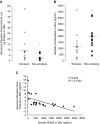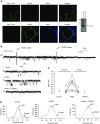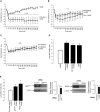Receptor for advanced glycation end-products regulates lung fluid balance via protein kinase C-gp91(phox) signaling to epithelial sodium channels
- PMID: 24978055
- PMCID: PMC5455303
- DOI: 10.1165/rcmb.2014-0002OC
Receptor for advanced glycation end-products regulates lung fluid balance via protein kinase C-gp91(phox) signaling to epithelial sodium channels
Abstract
The receptor for advanced glycation end-products (RAGE), a multiligand member of the Ig family, may play a crucial role in the regulation of lung fluid balance. We quantified soluble RAGE (sRAGE), a decoy isoform, and advanced glycation end-products (AGEs) from the bronchoalveolar lavage fluid of smokers and nonsmokers, and tested the hypothesis that AGEs regulate lung fluid balance through protein kinase C (PKC)-gp91(phox) signaling to the epithelial sodium channel (ENaC). Human bronchoalveolar lavage samples from smokers showed increased AGEs (9.02 ± 3.03 μg versus 2.48 ± 0.53 μg), lower sRAGE (1,205 ± 292 pg/ml versus 1,910 ± 263 pg/ml), and lower volume(s) of epithelial lining fluid (97 ± 14 ml versus 133 ± 17 ml). sRAGE levels did not predict ELF volumes in nonsmokers; however, in smokers, higher volumes of ELF were predicted with higher levels of sRAGE. Single-channel patch clamp analysis of rat alveolar epithelial type 1 cells showed that AGEs increased ENaC activity measured as the product of the number of channels (N) and the open probability (Po) (NPo) from 0.19 ± 0.08 to 0.83 ± 0.22 (P = 0.017) and the subsequent addition of 4-hydroxy-2, 2, 6, 6-tetramethylpiperidine-N-oxyl decreased ENaC NPo to 0.15 ± 0.07 (P = 0.01). In type 2 cells, human AGEs increased ENaC NPo from 0.12 ± 0.05 to 0.53 ± 0.16 (P = 0.025) and the addition of 4-hydroxy-2, 2, 6, 6-tetramethylpiperidine-N-oxyl decreased ENaC NPo to 0.10 ± 0.03 (P = 0.013). Using molecular and biochemical techniques, we observed that inhibition of RAGE and PKC activity attenuated AGE-induced activation of ENaC. AGEs induced phosphorylation of p47(phox) and increased gp91(phox)-dependent reactive oxygen species production, a response that was abrogated with RAGE or PKC inhibition. Finally, tracheal instillation of AGEs promoted clearance of lung fluid, whereas concomitant inhibition of RAGE, PKC, and gp91(phox) abrogated the response.
Keywords: acute respiratory distress syndrome; alveolar microenvironment; chronic obstructive pulmonary disease; lung injury; pulmonary edema.
Figures








Similar articles
-
Nadph oxidase regulates alveolar epithelial sodium channel activity and lung fluid balance in vivo via O⁻₂ signaling.Am J Physiol Lung Cell Mol Physiol. 2012 Feb 15;302(4):L410-9. doi: 10.1152/ajplung.00260.2011. Epub 2011 Dec 9. Am J Physiol Lung Cell Mol Physiol. 2012. PMID: 22160304 Free PMC article.
-
Rac1-mediated NADPH oxidase release of O2- regulates epithelial sodium channel activity in the alveolar epithelium.Am J Physiol Lung Cell Mol Physiol. 2010 Apr;298(4):L509-20. doi: 10.1152/ajplung.00230.2009. Epub 2010 Jan 22. Am J Physiol Lung Cell Mol Physiol. 2010. PMID: 20097736 Free PMC article.
-
AGER1 regulates endothelial cell NADPH oxidase-dependent oxidant stress via PKC-delta: implications for vascular disease.Am J Physiol Cell Physiol. 2010 Mar;298(3):C624-34. doi: 10.1152/ajpcell.00463.2009. Epub 2009 Dec 2. Am J Physiol Cell Physiol. 2010. PMID: 19955485 Free PMC article.
-
The receptor for advanced glycation end products and acute lung injury/acute respiratory distress syndrome.Intensive Care Med. 2012 Oct;38(10):1588-98. doi: 10.1007/s00134-012-2624-y. Epub 2012 Jul 10. Intensive Care Med. 2012. PMID: 22777515 Review.
-
The AGE-RAGE Axis and RAGE Genetics in Chronic Obstructive Pulmonary Disease.Clin Rev Allergy Immunol. 2021 Apr;60(2):244-258. doi: 10.1007/s12016-020-08815-4. Epub 2020 Nov 10. Clin Rev Allergy Immunol. 2021. PMID: 33170477 Review.
Cited by
-
Hydrogen Peroxide Stimulates Exosomal Cathepsin B Regulation of the Receptor for Advanced Glycation End-Products (RAGE).J Cell Biochem. 2018 Jan;119(1):599-606. doi: 10.1002/jcb.26219. Epub 2017 Sep 11. J Cell Biochem. 2018. PMID: 28618037 Free PMC article.
-
Response of the ileum transcriptome to probiotic and fructo-oligosaccharides in Taiping chicken.J Appl Genet. 2021 May;62(2):307-317. doi: 10.1007/s13353-021-00624-5. Epub 2021 Feb 27. J Appl Genet. 2021. PMID: 33638812
-
Cytokine-Ion Channel Interactions in Pulmonary Inflammation.Front Immunol. 2018 Jan 4;8:1644. doi: 10.3389/fimmu.2017.01644. eCollection 2017. Front Immunol. 2018. PMID: 29354115 Free PMC article. Review.
-
Helicobacter Pylori Infection and Lung Cancer: New Insights and Future Challenges.Zhongguo Fei Ai Za Zhi. 2018 Sep 20;21(9):658-662. doi: 10.3779/j.issn.1009-3419.2018.09.03. Zhongguo Fei Ai Za Zhi. 2018. PMID: 30201063 Free PMC article. Review.
-
Inhibition of the Receptor for Advanced Glycation End-Products in Acute Respiratory Distress Syndrome: A Randomised Laboratory Trial in Piglets.Sci Rep. 2019 Jun 25;9(1):9227. doi: 10.1038/s41598-019-45798-5. Sci Rep. 2019. PMID: 31239497 Free PMC article.
References
-
- Schmidt AM, Yan SD, Yan SF, Stern DM. The biology of the receptor for advanced glycation end products and its ligands. Biochim Biophys Acta. 2000;1498:99–111. - PubMed
-
- Schmidt AM, Stern DM. Receptor for AGE (RAGE) is a gene within the major histocompatibility class III region: implications for host response mechanisms in homeostasis and chronic disease. Front Biosci. 2001;6:D1151–D1160. - PubMed
-
- Crapo JD, Barry BE, Gehr P, Bachofen M, Weibel ER. Cell number and cell characteristics of the normal human lung. Am Rev Respir Dis. 1982;126:332–337. - PubMed
-
- Fehrenbach H, Kasper M, Tschernig T, Shearman MS, Schuh D, Muller M. Receptor for advanced glycation endproducts (RAGE) exhibits highly differential cellular and subcellular localisation in rat and human lung. Cell Mol Biol (Noisy -le-grand) 1998;44:1147–1157. - PubMed
Publication types
MeSH terms
Substances
Grants and funding
LinkOut - more resources
Full Text Sources
Miscellaneous

